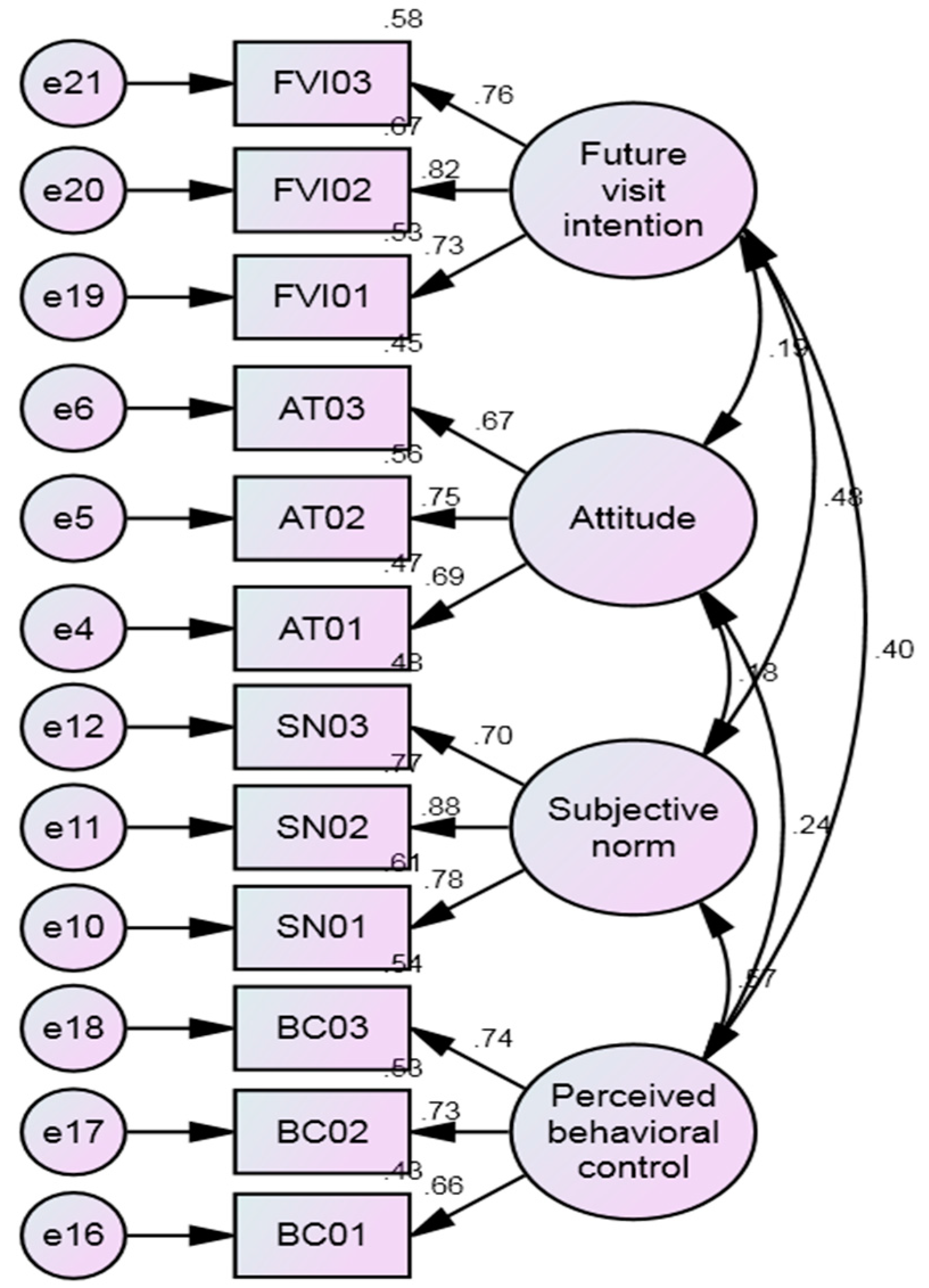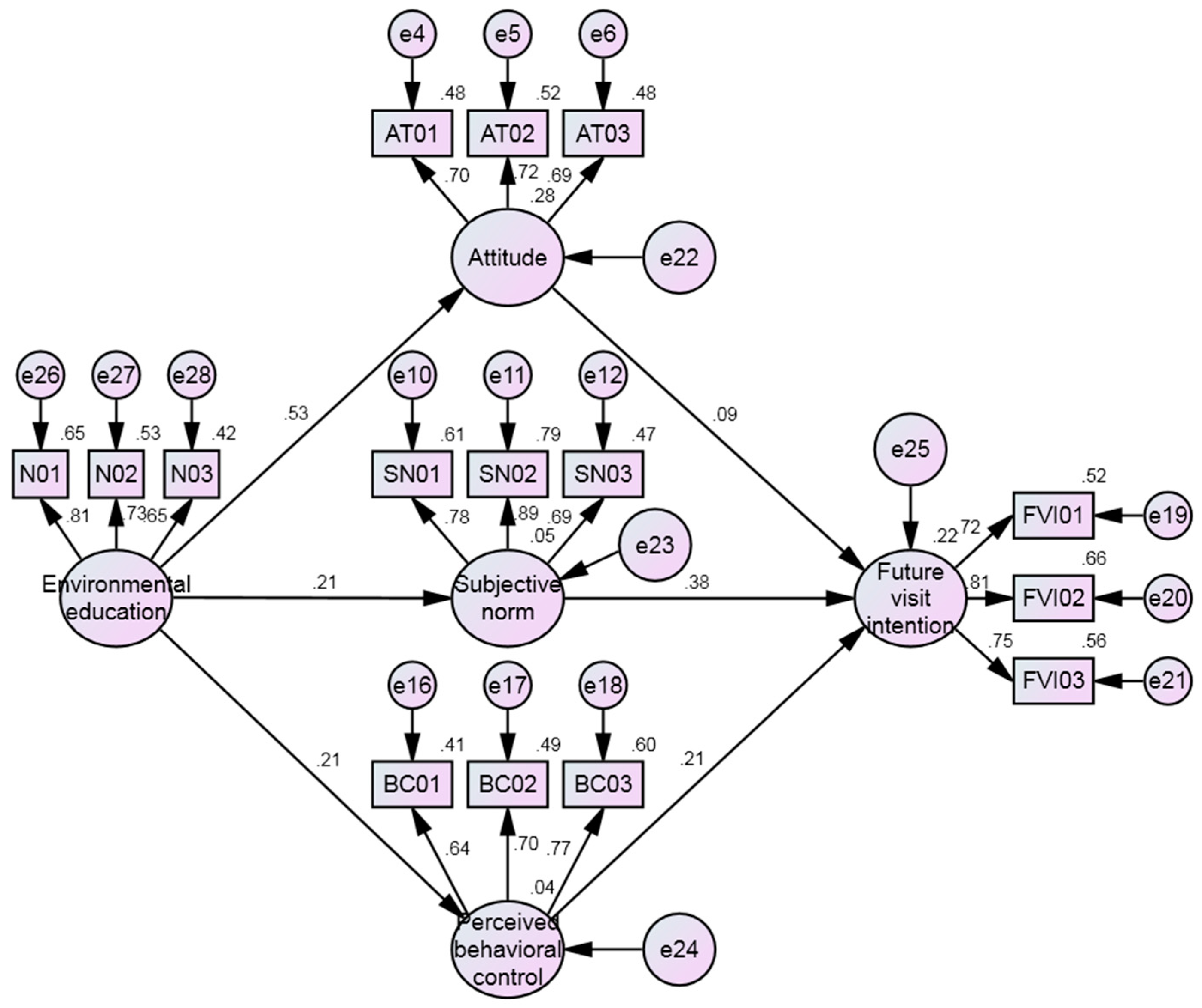Understanding the Impact of Environmental Education on Tourists’ Future Visit Intentions to Leisure Farms in Mountain Regions
Abstract
1. Introduction
1.1. Background
1.2. Research Problem
1.3. Research Purpose and Objectives
2. Literature Review
2.1. Environmental Education
2.2. Theory of Planned Behavior
2.3. Future Visit Intention
2.4. Research Framework and Hypotheses
- H1: Visitor with high EE is more likely to have positive AT,
- H2: Visitor with high EE is more likely to have positive SN,
- H3: Visitor with high EE is more likely to have positive BC,
- H4: Visitor with high AT is more likely to have positive FVI,
- H5: Visitor with high SN is more likely to have positive FVI, and
- H6: Visitor with high BC is more likely to have positive FVI.
3. Research Methodology
3.1. Locale of the Study
3.2. Sampling Method
3.3. Measurement of Variables
3.4. Pretesting of the Instrument
3.5. Data Analysis
4. Results
4.1. Respondent Characteristics
4.2. Mean Score Analyses
4.3. Exploratory Factor Analysis (EFA) for Construct Validness
4.4. Confirmatory Factor Analysis (CFA) for Model Goodness of Fit
4.5. Composite Reliability and Discriminate Validity
4.6. Hypotheses Testing
5. Conclusions, Contribution, Implication, and Recommendation
5.1. Conclusions
5.2. Theoretical Contribution
5.3. Managerial Implication
5.4. Recommendation to Future Research
Author Contributions
Funding
Acknowledgments
Conflicts of Interest
References
- Chan, E.S.W. Barriers to EMS in the hotel industry. Int. J. Hosp. Manag. 2008, 27, 187–196. [Google Scholar] [CrossRef]
- Best, M.N.; Thapa, B. Motives, facilitators and constraints of environmental management in the Caribbean accommodations sector. J. Clean. Prod. 2013, 52, 165–175. [Google Scholar] [CrossRef]
- Chang, L.-H.; Tsai, C.-H.; Yeh, S.-S. Evaluation of Green Hotel Guests’ Behavioral Intention; Chen, J.S., Ed.; Emerald Group Publishing Limited: Bingley, UK, 2014; Volume 10, pp. 75–89. [Google Scholar]
- Rennings, K. Redefining innovation—Eco-innovation research and the contribution from ecological economics. Ecol. Econ. 2000, 32, 319–332. [Google Scholar] [CrossRef]
- Han, H.; Hsu, L.-T.J.; Lee, J.-S.; Sheu, C. Are lodging customers ready to go green? An examination of attitudes, demographics, and eco-friendly intentions. Int. J. Hosp. Manag. 2011, 30, 345–355. [Google Scholar] [CrossRef]
- Ajzen, I. The theory of planned behavior. Organ. Behav. Hum. Decis. Process. 1991, 50, 179–211. [Google Scholar] [CrossRef]
- Han, H.; Hsu, L.T.; Sheu, C. Application of the theory of planned behavior to green hotel choice: Testing the effect of environmental friendly activities. Tour. Manag. 2010, 31, 325–334. [Google Scholar] [CrossRef]
- Han, H.; Kim, Y. An investigation of green hotel customers’ decision formation: Developing an extended model of the theory of planned behavior. Int. J. Hosp. Manag. 2010, 29, 659–668. [Google Scholar] [CrossRef]
- Kopnina, H. Revisiting education for sustainable development (ESD): Examining anthropocentric bias through the transition of environmental education to ESD. Sustain. Dev. 2011, 22, 73–83. [Google Scholar] [CrossRef]
- Ko, E.; Hwang, Y.K.; Kim, E.Y. Green marketing’ functions in building corporate image in the retail setting. J. Bus. Res. 2013, 66, 1709–1715. [Google Scholar] [CrossRef]
- Badulescu, D.; Badulescu, A.; Bac, D.P.; Saveanu, T.; Florea, A.; Perticas, D. Education and Sustainable Development: From Theoretical interest to specific behaviours. J. Environ. Prot. Ecol. 2017, 18, 1698–1705. [Google Scholar]
- Leonidou, L.; Leonidou, C.; Kvasova, O. Antecedents and Outcomes of Consumer Environmentally-Friendly Attitudes and Behavior. J. Mark. Manag. 2010, 26, 1319–1344. [Google Scholar] [CrossRef]
- Bell, D.R. Creating green citizens? Political liberalism and environmental education. J. Philos. Educ. 2004, 38, 37–54. [Google Scholar] [CrossRef]
- Morgan, S.C.; Hamilton, S.L.; Bentley, M.L.; Myrie, S. Environmental education in botanic gardens: Exploring brooklyn botanic garden’s project green reach. J. Environ. Educ. 2009, 40, 35–52. [Google Scholar] [CrossRef]
- Kollmuss, A.; Agyeman, J. Mind the gap: Why do people act environmentally and what are the barriers to pro-environmental behavior? Environ. Educ. Res. 2002, 8, 239–260. [Google Scholar] [CrossRef]
- Stapp, W.B.; Bennett, D.; Bryan, W.; Fulton, J.; MacGregor, J.; Nowak, P.; Havlick, S. The concept of environmental education. J. Environ. Educ. 1969, 1, 30–31. [Google Scholar] [CrossRef]
- Yeh, S.-S.; Ma, T.; Huan, T.C. Building social entrepreneurship for the hotel industry by promoting environmental education. International J. Contemp. Hosp. Manag. 2016, 28, 1204–1224. [Google Scholar] [CrossRef]
- Pan, S.-L.; Chou, J.; Morrison, A.M.; Huang, W.-S.; Lin, M.-C. Will the Future Be Greener? The Environmental Behavioral Intentions of University Tourism Students. Sustainability 2018, 10, 634. [Google Scholar] [CrossRef]
- Hsu, C.H.C.; Huang, S.S. An extension of the theory of planned behavior model for tourists. J. Hosp. Tour. Res. 2012, 36, 390–417. [Google Scholar] [CrossRef]
- Liang, Y.-P. The Relationship between Consumer Product Involvement, Product Knowledge and Impulsive Buying Behavior. Procedia Soc. Behav. Sci. 2012, 57, 325–330. [Google Scholar] [CrossRef]
- McKercher, B.; Tony, S.M. Is intention to return a valid proxy for actual repeat visitation? J. Travel Res. 2012, 51, 671–686. [Google Scholar] [CrossRef]
- Kim, Y.J.; Njite, D.; Hancer, M. Anticipated emotion in consumers’ intentions to select eco-friendly restaurants: Augmenting the theory of planned behavior. Int. J. Hosp. Manag. 2013, 34, 255–262. [Google Scholar] [CrossRef]
- Chen, M.-F.; Tung, P.-J. Developing an extended Theory of Planned Behavior model to predict consumers’ intention to visit green hotels. Int. J. Hosp. Manag. 2014, 36, 221–230. [Google Scholar] [CrossRef]
- Han, H. Travelers’ pro-environmental behavior in a green lodging context: Converging value-belief-norm theory and the theory of planned behavior. Tour. Manag. 2015, 47, 164–177. [Google Scholar] [CrossRef]
- Kuminoff, N.V.; Zhang, C.; Rudi, J. Are travelers willing to pay a premium to stay at a “green” hotel? Evidence from an internal meta-analysis of hedonic price premia. Agric. Resour. Econ. Rev. 2010, 39, 468. [Google Scholar] [CrossRef]
- Roe, B.; Teisl, M.F.; Levy, A.; Russell, M. US consumers’ willingness to pay for green electricity. Energy Policy 2001, 29, 917–925. [Google Scholar] [CrossRef]
- Hair, J.F.; Black, W.C.; Babin, B.J.; Anderson, R.E. Multivariate Data Analysis, 7th ed.; Prentice Hall: Englewood Cliffs, NJ, USA, 2009. [Google Scholar]
- Artuger, S.; Kendir, H. Agritourist motivations: The case of Turkey. Int. J. Bus. Manag. 2013, 8, 63–69. [Google Scholar] [CrossRef]
- Rid, W.; Ezeuduji, I.O.; Pröbstl-Haider, U. Segmentation by motivation for rural tourism activities in The Gambia. Tour. Manag. 2014, 40, 102–116. [Google Scholar] [CrossRef]
- Vassiliadis, C.A.; Priporas, C.-V.; Andronikidis, A. An analysis of visitor behaviour using time blocks: A study of ski destinations in Greece. Tour. Manag. 2013, 34, 61–70. [Google Scholar] [CrossRef]
- Fornell, C.; Larcker, D.F. Structural equation models with unobservable variables and measurement error: Algebra and statistics. J. Mark. Res. 1981, 18, 382–388. [Google Scholar] [CrossRef]
- Hooper, D.; Coughlan, J.; Mullen, M. Structural equation modelling: Guidelines for determining model fit. The Electronic J. Bus. Methods 2008, 6, 53–60. [Google Scholar] [CrossRef]
- Bearden, W.O.; Sharma, S.; Teel, J.E. Sample size effects on chi square and other statistics used in evaluating causal models. J. Mark. Res. 1982, 19, 425–430. [Google Scholar] [CrossRef]
- Kline, R.B. Principles and Practice of Structural Equation Modeling; Guilford Press: New York, NY, USA, 2011. [Google Scholar]



| Code | Description | Mean | SD |
|---|---|---|---|
| AT01 | I am very fond of the farm stay | 3.87 | 0.75 |
| AT02 | Coming to the farm stay is a right choice for my holiday | 4.08 | 0.75 |
| AT03 | The farm stay provides high quality experience | 4.07 | 0.77 |
| SN01 | My companions all support the visit to the farm stay | 3.79 | 0.84 |
| SN02 | People I know have high opinion about the farm stay | 3.68 | 0.86 |
| SN03 | The search on the Internet turns up some positive comment | 3.49 | 0.88 |
| BC01 | The farm stay is in the vicinity of my residence | 4.09 | 0.75 |
| BC02 | The farm stay is accessible to me | 3.90 | 0.81 |
| BC03 | The visit to the farm stay is affordable | 3.93 | 0.84 |
| FVI01 | I like to visit the farm stay again in the future | 4.06 | 0.70 |
| FVI02 | I am willing to pay a premium to support the environment | 4.03 | 0.72 |
| FVI03 | I will recommend my friends to visit the farm stay | 3.86 | 0.78 |
| 1 | 2 | 3 | 4 | |
|---|---|---|---|---|
| AT01 | 0.792 | |||
| AT02 | 0.825 | |||
| AT03 | 0.804 | |||
| SN01 | 0.818 | |||
| SN02 | 0.855 | |||
| SN03 | 0.775 | |||
| BC01 | 0.733 | |||
| BC02 | 0.772 | |||
| BC03 | 0.827 | |||
| FVI01 | 0.839 | |||
| FVI02 | 0.854 | |||
| FVI03 | 0.786 | |||
| Eigenvalue | 3.986 | 1.901 | 1.47 | 1.119 |
| % Variance | 33.221 | 15.842 | 12.252 | 9.323 |
| Cumulative % | 33.221 | 49.063 | 61.315 | 70.638 |
| CR | AVE | MSV | ASV | BC | AT | SN | FVI | |
|---|---|---|---|---|---|---|---|---|
| BC | 0.751 | 0.502 | 0.325 | 0.181 | 0.708 | |||
| AT | 0.747 | 0.497 | 0.058 | 0.041 | 0.240 | 0.705 | ||
| SN | 0.830 | 0.622 | 0.325 | 0.194 | 0.570 | 0.176 | 0.789 | |
| FVI | 0.814 | 0.594 | 0.227 | 0.141 | 0.401 | 0.188 | 0.476 | 0.771 |
| Hypotheses | Paths | Unstd. β | p | β |
|---|---|---|---|---|
| H1 | EE→AT | 0.397 | *** | 0.53 |
| H2 | EE→SN | 0.2 | *** | 0.214 |
| H3 | EE→BC | 0.145 | *** | 0.21 |
| H4 | AT→FVI | 0.09 | 0.055 | 0.094 |
| H5 | SN→FVI | 0.293 | *** | 0.384 |
| H6 | BC→FVI | 0.217 | *** | 0.21 |
| Cause | Effect | β | Result | |||
|---|---|---|---|---|---|---|
| H1 | Environmental education | → | Attitude | 0.530 | *** | Supported |
| H2 | Environmental education | → | Subjective norm | 0.214 | *** | Supported |
| H3 | Environmental education | → | Perceived behavioral control | 0.210 | *** | Supported |
| H4 | Attitude | → | Future visit intention | 0.094 | Rejected | |
| H5 | Subjective norm | → | Future visit intention | 0.384 | *** | Supported |
| H6 | Perceived behavioral control | → | Future visit intention | 0.210 | *** | Supported |
© 2019 by the authors. Licensee MDPI, Basel, Switzerland. This article is an open access article distributed under the terms and conditions of the Creative Commons Attribution (CC BY) license (http://creativecommons.org/licenses/by/4.0/).
Share and Cite
Leelapattana, W.; Hsu, S.-Y.; Thongma, W.; Chen, C.; Chiang, F.-M. Understanding the Impact of Environmental Education on Tourists’ Future Visit Intentions to Leisure Farms in Mountain Regions. Sustainability 2019, 11, 1567. https://doi.org/10.3390/su11061567
Leelapattana W, Hsu S-Y, Thongma W, Chen C, Chiang F-M. Understanding the Impact of Environmental Education on Tourists’ Future Visit Intentions to Leisure Farms in Mountain Regions. Sustainability. 2019; 11(6):1567. https://doi.org/10.3390/su11061567
Chicago/Turabian StyleLeelapattana, Winitra, Shih-Yun Hsu, Weerapon Thongma, Chun Chen, and Fu-Mei Chiang. 2019. "Understanding the Impact of Environmental Education on Tourists’ Future Visit Intentions to Leisure Farms in Mountain Regions" Sustainability 11, no. 6: 1567. https://doi.org/10.3390/su11061567
APA StyleLeelapattana, W., Hsu, S.-Y., Thongma, W., Chen, C., & Chiang, F.-M. (2019). Understanding the Impact of Environmental Education on Tourists’ Future Visit Intentions to Leisure Farms in Mountain Regions. Sustainability, 11(6), 1567. https://doi.org/10.3390/su11061567





